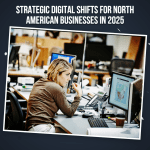Artificial intelligence is no longer a distant concept or a tool reserved for large enterprises. In 2025, AI has become a central driver of how small and medium-sized businesses in Canada and the United States design their strategies, engage with customers, and remain competitive in a rapidly evolving marketplace. What once required large budgets and expansive teams can now be achieved with intelligent automation, personalized content creation, and data-driven decision-making.
The implications for SMBs are significant. Machine readiness, automation, and customization are no longer optional. They are the foundation of success. Businesses that fail to adapt risk falling behind competitors who are already embedding AI into their marketing playbooks.
This article explores how AI is transforming consumer behavior, reshaping the marketer’s role, reconfiguring marketing technology stacks, and redefining the four Ps of marketing for a new era.
The New Consumer Decision Journey
Consumer decision-making has shifted in a fundamental way. Increasingly, the first interaction between a customer and a product is not direct. AI-powered assistants, recommendation engines, and shopping bots are filtering the available choices before a consumer even views them.
For small businesses, this means that visibility now depends on how machine-readable and differentiated their products or services are. Traditional techniques such as repetitive slogans or wide-spread ads are less effective. AI evaluates relevance and fit before a product is ever presented.
Consider a small skincare brand. In the past, attractive packaging and a consistent tagline may have been enough to draw attention. In 2025, an AI shopping assistant might instead prioritize products with verified ingredient transparency, strong customer reviews, and structured data that proves trustworthiness. If that information is not provided, the product is likely to be excluded entirely from the shortlist of options shown to the buyer.
The lesson is clear. Differentiation must be documented, visible, and machine-ready. Businesses cannot afford to rely on traditional marketing noise.
The Marketer’s Role: From Executor to Strategic Leader
Automation has changed the day-to-day role of marketers. Tasks such as audience segmentation, campaign scheduling, and creative testing can now be completed by AI systems. However, this does not diminish the importance of human oversight. In fact, the role of the marketer is more strategic than ever.
Marketers are now responsible for orchestration. They must align AI-driven efficiencies with long-term brand strategy, ensuring that automation supports rather than dilutes a company’s identity. While AI excels at analyzing patterns and optimizing performance, it cannot replicate human judgment, creativity, and cultural awareness.
A Canadian travel agency offers an instructive example. AI can manage campaigns that test hundreds of variations of imagery and copy, identifying which combinations generate the highest conversions. But the decision to highlight sustainable tourism or community-based experiences remains a human one. Those choices align with brand values and resonate emotionally with customers, creating differentiation that machines alone cannot achieve.
Modular Marketing Stacks: Flexibility as a Strategic Advantage
The era of large, one-size-fits-all marketing platforms is waning. Instead, small businesses are increasingly adopting modular marketing technology stacks, where specialized AI tools perform distinct functions and integrate seamlessly with one another.
This modular approach provides several advantages. It allows businesses to select best-in-class solutions for social media management, content optimization, customer insights, and analytics. It also gives them the ability to adjust quickly as needs evolve, without being locked into rigid systems.
For instance, a small retailer might use one AI-powered platform for inventory forecasting, another for personalized email campaigns, and a third for social media scheduling. A smart orchestration layer ensures these tools communicate, maintaining efficiency across the system.
However, the success of a modular stack depends on data quality. Clean, structured, and accessible data is essential. Without it, even the most advanced AI tools will deliver limited results. Organizing and standardizing data is therefore one of the most important investments a small business can make in 2025.
Reframing the Four Ps of Marketing for the AI Era
The classic framework of Product, Price, Place, and Promotion remains relevant, but each dimension has been redefined by AI.
Product: Personalization at Scale
AI makes it possible for SMBs to deliver customized experiences once thought to be the exclusive domain of large corporations. A small supplement provider can now allow customers to create personalized vitamin packs based on health goals. A boutique clothing store can offer AI-generated recommendations that adapt to style preferences and seasonality.
Personalization fosters loyalty by giving customers the impression that products are designed specifically for them. It is also a powerful way to differentiate in crowded markets.
Price: Dynamic Yet Transparent
Dynamic pricing has become more accessible, with AI engines adjusting prices in real time based on demand, inventory, and competitor actions. While this provides opportunities for margin optimization, transparency is crucial. Customers are increasingly aware of hidden price shifts and will lose trust if they feel manipulated.
Businesses should therefore prioritize fairness and explain the value behind their pricing models. For example, a restaurant adjusting delivery fees during peak hours should clearly communicate that the increase reflects delivery capacity, not arbitrary changes. Transparency builds credibility and long-term loyalty.
Place: Omnichannel and Machine-Optimized
Place no longer refers only to physical locations or traditional online stores. Products must be discoverable across multiple channels where AI systems are active. This includes Google’s AI-driven search results, digital shopping assistants, and social commerce platforms.
For a small pet supply company, this might mean ensuring that product descriptions include structured data, verified certifications, and clear customer reviews. Without these elements, AI systems may ignore the listing entirely. Businesses must optimize for both human and machine discovery.
Promotion: Structured and Story-Driven
Promotion is no longer solely about human appeal. Content must also be structured in ways machines can understand and amplify. Metadata, schema, and contextual information are now critical components of successful promotion strategies.
At the same time, human storytelling remains essential. AI can place content in front of the right audience at the right time, but it cannot generate the emotional connection that builds brand loyalty. A craft brewery promoting a seasonal release, for example, must provide structured product information while also sharing the authentic story of the brewing process and community involvement.
A Practical Roadmap for SMBs in 2025
To thrive in this new environment, SMBs should adopt a structured approach to transformation. A practical 30-day roadmap could include:
Week 1: Foundation Building
Audit all online listings to ensure accuracy and completeness. Update product descriptions, hours, and categories. Add structured data to your website for better machine readability.
Week 2: Content and Communication
Publish FAQs addressing common customer questions in your industry. Provide clear, authoritative answers that can feed into AI-generated search results.
Week 3: Responsible Automation
Launch a limited automated campaign using AI tools. Set budget caps and performance metrics. Monitor the campaign closely to ensure alignment with brand strategy.
Week 4: Evaluation and Refinement
Analyze campaign performance and customer engagement. Strengthen successful elements and refine underperforming ones. Establish guardrails for AI systems to maintain oversight and control.
Strategic Outlook
AI is reshaping the foundations of small business marketing across Canada and the United States. Machine readiness, automation, and personalization are no longer enhancements but core requirements for success.
The businesses that adapt quickly will find themselves ahead of competitors still relying on outdated strategies. By investing in structured data, modular marketing stacks, and transparent pricing, SMBs can ensure that their offerings are visible, trustworthy, and compelling in both human and machine-driven environments.
Artificial intelligence does not eliminate the importance of human marketers. Rather, it elevates their role from tactical execution to strategic leadership. By blending the precision of AI with the creativity of people, small businesses can not only survive but thrive in 2025 and beyond.









